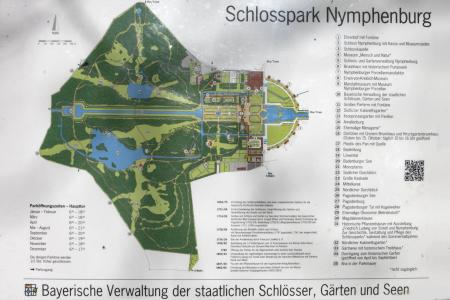Nymphenburg Park - Schlosspark Nymphenburg
Nymphenburg Park - Schlosspark Nymphenburg
The park and gardens around Nymphenburg Palace with its small castles, canals and a lake are one of the largest and outstanding pieces of garden art in Germany. The 180 hectars of the garden are nearly completely surrounded by a historic garden wall. In the north of the park the Botanic Garden is situated.
Driving up the Nördliche- or Südliche Auffahrtsalle along the Nymphenburg canal towards the palace one has a magnificent view of the castle grounds and the pond with many ducks and swans. Behind the palace the extensive gardens begin.
Depending on the season the opening hours of the park change. Therefore when entering the park one should have look at the sign near the entrance.
The history of Nymphenburg Palace Park
The history of the palace and the park of Nymphenburg are inextricably linked, and cover a period of more than 300 years. From 1664, Electress Henriette Adelaide of Savoy had a summer palace built from plans by the Bologna architect Agostino Barelli, with a small ornamental garden on its west side. Henriette Adelaide´s garden was completely swallowed up by the park that was created later on. In 1701 Max Emanuel began extending his mother´s palace, and also the gardens, which were planned and produced by Charles Carbonet, a pupil of Versailles creator André Le Nôtre. He was probably responsible for the canal which was laid out from 1701 in the existing break in the trees in order to divert water into the garden from the River Würm two kilometres away.
The transformation of the palace and gardens into a famous baroque complex at the hands of Dominique Girard and the Bavarian court architect Joseph Effner did not however properly begin until 1715. It was now that the Nymphenburg canal system was completed and the garden was provided with a variety of water features and the necessary pumping machinery, and refinements were made to the design of the parterre, the hedge gardens and the extensive wooded park.
By the end of Max Emanuel´s reign (1726), there was an axially symmetrical garden radiating out from the west side of the palace, which was dominated by the four sections of the "Large Parterre", laid out with ornamental flowerbeds close to the palace. In the centre where the paths intersected was the "Large Pool" with the Flora Fountain. The boskets on either side of the parterre contained a number of garden rooms equipped for the pastimes of the court society.
You can display Google's 3D map by clicking on the image below. A connection to the Google servers is only established with this click. Please read our information on Privacy Policy.
Nymphenburg Park at a glance!
Photos
Nymphenburg Park - Map
Listen to Informations of Nymphenburg Park as audio
QR-Code Mobile-Version
Address and Links
Text: www.schloesser.bayern.de



